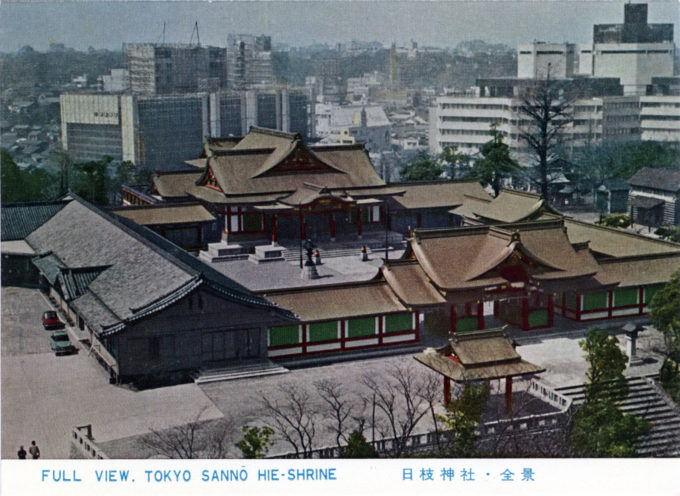
“Full View, Sannō Hie Shrine”, Nagatacho, Tokyo, c. 1960, surrounded by a city still reemerging from wartime destruction into postwar prosperity. Much of the main shrine structure was destroyed during the Tokyo firebombings (1945), and was rebuilt in the years after the Pacific War. During the period of State Shintoism lasting from 1871-1945, Hie Shrine was designated among the first-rank of government-supported shrines — which totaled only sixty-seven shrines nationwide, but including nearby Meiji Shrine. Within the shrine premises is the Sanno Inari Jinja, sporting 90 vermillion torii gates that wind up a staircase leading from the street.
See also:
Dedication of Meiji Shrine, Tokyo, 1920.
“The date of establishment of the Hie Shrine is uncertain. According to one theory, Ōta Dōkan established it in 1478. Another theory identifies the Hie with the Sannō Shrine mentioned in a 1362 record of the Kumano Nachi Taisha.
“Tokugawa Ieyasu relocated it to the grounds of Edo Castle, and in 1604 his son Tokugawa Hidetada moved it out, so the people of Edo could worship there. The shaden (main building) was lost to the Great Fire of Meireki of 1657, and in 1659 Tokugawa Ietsuna rebuilt it at its present location. The shrine stands southwest of the castle, in the ura kimon (‘devil’s gate) direction according to onmyōdō (‘The Way of Yin and Yang’).
“From 1871 through 1946, the Hie Shrine was officially designated one of the Kanpei-taisha (the hierarchy of shrines most closely associated with the imperial family), meaning that it stood in the first rank of government-supported shrines.
“The shaden was lost again to the bombing of Tokyo during World War II. The present structure dates from 1958.
“The Hie Shrine possesses one National Treasure, a tachi (single-edged sword). It also holds 14 Important Cultural Assets, 13 swords and one naginata (pole weapon). The shrine is also one of the most popular for Japanese families to visit during the Shichi-Go-San coming-of-age festival.”
– Wikipedia

